I just got my first upright and need some tips on getting started. Definitely a different animal than my electric basses, but I love her already! She is a beautiful 1937 Kay Alvin Hawes Blond (M-4) in great condition. A late 1930s Glasser wooden German bow came with it as well. I am very excited to start this next journey!
Congratulations, first of all!
That’s a beautiful bass and, sneaking a peek around her lovely bouts, among some other lovely instrument company.
Getting started on upright can be tricky, particularly if you want to use the bow.
Any upright teacher that is going to teach the bow will most likely come from solid classical background and may (but may not) also have jazz training.
I’d highly recommend in-person lessons to get oriented with the correct posture and technique.
It’ll be super valuable to have an experienced person watching and correcting you in the early days.
Once you feel like you have a handle on the basics or you can target your goals more clearly, online tutorials may help?
I’ve struggled with this instrument since day one. It’s gorgeous and beastly. I wish you all the luck in the world!
Thank you! I would love to get some in person lessons to begin with, but must find someone willing to come to me, as she will not fit in my tiny car ![]() I am interested in learning some classical and jazz as well. At age 60, I just want to do as much as I can while I still can!
I am interested in learning some classical and jazz as well. At age 60, I just want to do as much as I can while I still can!
The Warwick Infinette (Streamer Corvette - precurser to the Infinity and the Corvette) looks at lot like the Kay!
As always Gio’s spot on. No matter what style you want to play, get some initial tutoring. You can probably find a teacher who is willing to come to you or one that will let you use (one of) their bass(es). I’ve done both. If they come to you, you want a space large enough for both of you. They might want to bring their Bass so you can play together which can be very helpful. Going to them has a few advantages; you are more likely to get to play together, they will have access to resources such as sheet music that is difficult to anticipate what to bring and you won’t have to clean the house. Using a teacher’s Bass can be challenging and fun. I did it as a student many times only bringing my bow to a dressing room at the orchestra hall. It is also good to let others see, hear and even try your bass. As they might be able to recommend adjustments if, for instance the sound post is off. I’ve taken a bass on the subway and the bus. Airplanes are the worst. And now there’s uber and Lyft. Teachers can be found through local colleges or if there is an orchestra nearby, they would probably have a potential teacher
Online google discovering double bass
Double bass hq (Jason Heath)
International society of bassists
Kays with gut strings are often favored by rockabilly (slap) and jazz traditionalists. Most orchestral players prefer high tension metal ($$$) strings
Coming from bass guitar will help you map out or visualize the notes and patterns on the upright. It will also help with intonation. Keep the bag off of it at home to make it more accessible. Try to play (if only for a little while) frequently or daily.
Be patient! You want to be loose and relaxed which ironically comes from repetition.
Don’t clench. Left hand fingers come in from above like a nautilus shell shape from your left shoulder or pulling someone close in order to whisper in their ear. Right hand cradles the bow. It is an extension of your fingers.
Thank you for the wonderful advice and tips! I have a gigantic music room in my home, so it would easily accommodate 2 or more people playing an upright bass. I am still searching for a teacher somewhat close by.
The gut strings on the bass are really (really) old. The D and G actually sound good, but the E and A do not produce much sound, or just a thud. Would you suggest light or medium gauge strings to play blues, jazz, funk, swing, along with starting to learn orchestral arrangements both bowed and plucked? Thanks!
Are you near any kind of violin shop? The thud on the lower strings could be from the sound post needing adjustment. The sound post is a dowel between the top and back of the bass. It transmits vibrations from the top (front) and back as well as keeping the top from caving in (a bit). Where it is placed and how tightly it fits will make a difference. It can be seen by looking through the f hole on the g string side of the bridge. I have a sound post adjuster but have always been too intimidated to try doing this myself. The sound post is held in place by tension. The strings need to be loosened to move it without going so far as to let it drop. Always change strings one at a time and get a string winder, either a crank or one that can be chucked into a drill (really!).
I mention this because going from gut to metal will likely take some changes to the set up of the bass. The notches for the strings on the bridge might be off and the tension on the top might be greater meaning a shorter post will work better. Also it looks like there are no adjuster wheels on the bridge. That can be a worthwhile upgrade.
I am only speculating and trying to call things to your attention. Your Bass might be fine with swapping gut to steal as is. It is hard to tell from photos
Main takeaways
Get a string winder
Do one string at a time
As you bring it up to pitch, keep an eye on the bridge which might be getting pulled with the string. Rub some graphite in the notch to help the string slide and minimize that. You want to keep the full foot of the bridge in touch with the top.
For strings check these venders
Southwest strings, lemur, Upton, shar, carriage house violins, bob’s house of Bass and golihur.
There should be some useful information on some of these sites and a phone call can be helpful
A D’adario hybrid might be good
Thank you for the great tips! I purchased an adjustable bridge that I will hopefully have a luthier put on, while they check everything else, like the sound post. I bought a set of Spirocore strings, but will try to replace only E and A and see how that sounds first.
Update: I finally got my Kay back from the luthier yesterday. She sounds great with her new setup and full set of Spirocore Weich strings. I found an in-person UB teacher and started lessons. I found a used Yamaha SLB300 to take to lessons, since that will fit in my car well (and my Kay was gone for so long). Now I realize I must learn to read sheet music and learn where the notes are on each string, as I have been using TABs to play. I will be going back through the B2B course again, trying to use the sheet music instead. I am loving my EB and now UB journey!!
Congratulations!
Best of everything to you in the UB journey!
One word about BassBuzz and upright:
We don’t do much chugging on upright, and a lot of the rock bass lines may not be helpful to try on upright.
I’m thinking about With or Without You, and similar things, or Billie Jean.
Those aren’t bass lines that are helpful to play on upright.
It might break your hands to do that, where it wouldn’t on electric.
Curious how a BassBuzz journey feels on it though - keep us posted!
I already completed BassBuzz on an electric bass and loved it. I am repeating the course on electric, not the upright. I have an in person teacher for upright who supplies me with material. For upright I want to learn classical and jazz, and how to bow, so a different but parallel journey ![]()
Ah - I get it!
Understood, and fully supported.
Interesting solution. They look fairly complementary from the photo. If the string length and neck blocks are similar, it will be easy to go from one to the other.
You can put some pin striping tape on the fingerboard for “training frets”. Chrome is nice and stands out. Available at most hobby shops or online somewhere. I’ve seen whiteout used to make a dot as well as pencil marks
By neck block I mean this: put your thumb on the back of the neck in the middle and drop it until it hits the heel of the neck. Then bring your first finger toward your thumb to stop or close the g string. Check the pitch. It will be either a d or an e flat. There is at least one method that starts the student from this position on the fingerboard assuming that it is a d neck. (George Vance’s progressive repertoire)
Use open strings and harmonics for reference and try to get the acoustic one to resonate as much as possible. This will help you to focus the intonation especially with the bow
I came soooooo close to buying an upright (complete with flames!) and when I went to the shop finally after hemming and hawing, one of the employees had taken it on a gig and loved it, and bought it! Under $2k, lots of used character and an endorsement from a pro. Dammit.
Thank you! The two uprights play very similary. My teacher is having me learn the D major scale, both plucking and bowing, and the finger placement is the same on both. I am really enjoying “starting over” to include learning to read sheet music and where notes are on the fingerboard; I only used TAB before with my electric basses.
Use a tuner to sound a drone d to play the scale with. Then have it sound an a drone and play the scale with that. Play long tones using the bow.
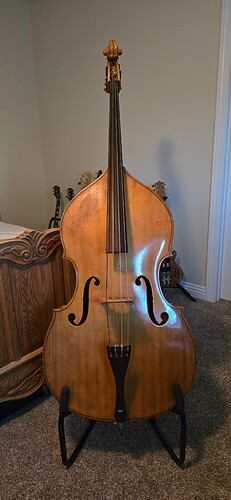
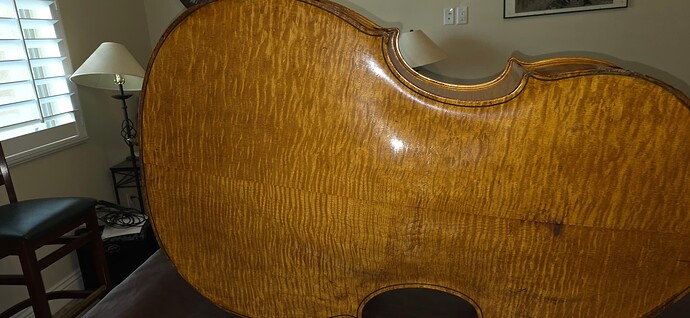
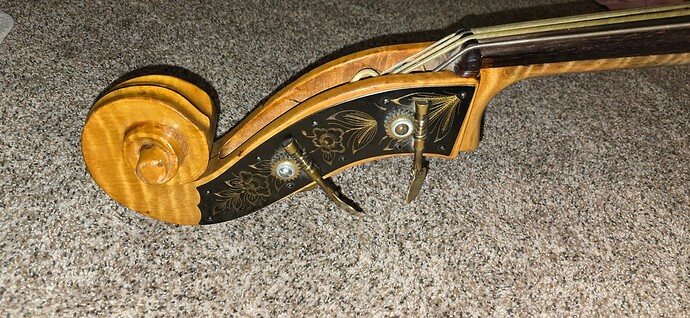
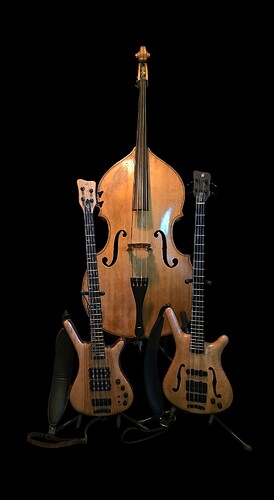
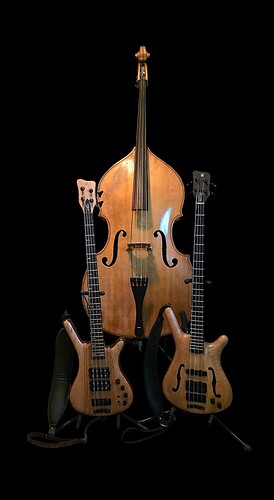
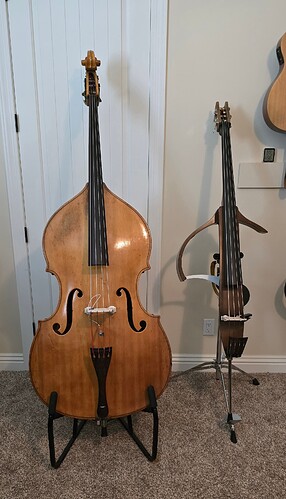

![Drone Track in EVERY Key [a practice track you really need!]](https://img.youtube.com/vi/4c-uNd-gxN4/maxresdefault.jpg)